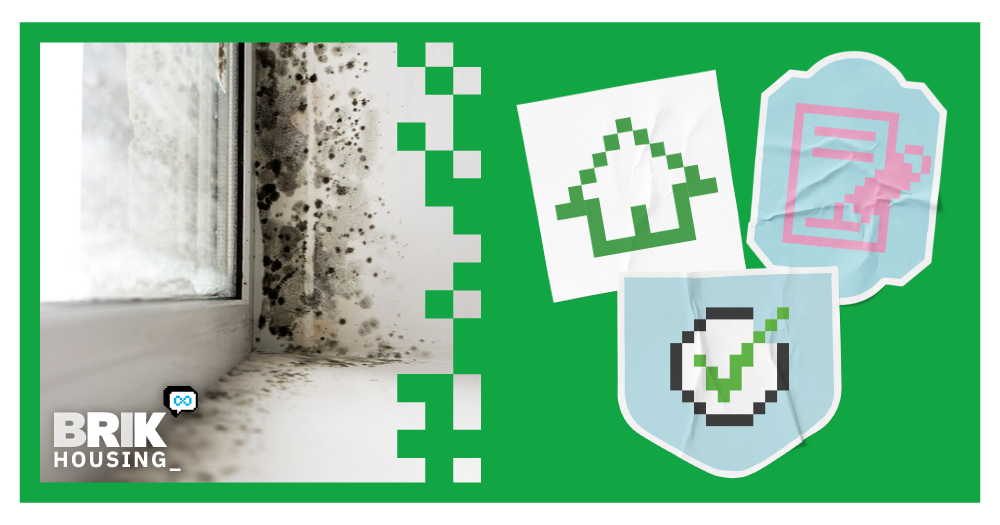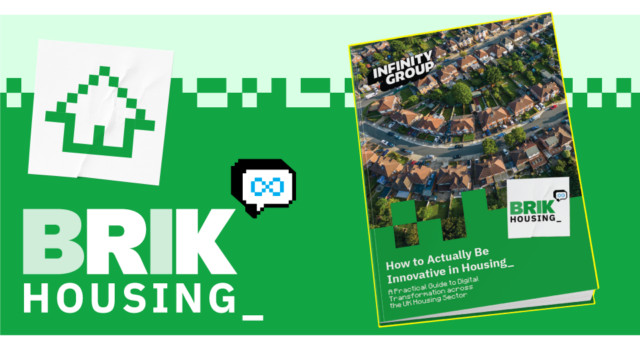Key takeaways
- Awaab’s Law introduces strict legal deadlines for investigating and fixing hazards like damp and mould in social housing, starting 27 October 2025.
- Housing associations must act fast: investigate emergency hazards within 24 hours, significant hazards within 10 days and keep full documentation to avoid fines and legal action.
- Digital solutions like BRIKHousing can automate workflows, track compliance in real time, and improve tenant communication—helping providers meet obligations and protect residents.
The introduction of Awaab’s Law marks a pivotal moment for the UK housing sector. Sparked by the tragic death of two-year-old Awaab Ishak due to prolonged exposure to mould in his family’s social housing flat, the legislation sets out strict new timelines for investigating and resolving health hazards in rented homes. For housing associations, this is a fundamental shift in how tenant safety and property standards are managed.
With Phase 1 of Awaab’s Law coming into force on 27 October 2025, housing providers must act swiftly to ensure they have the systems, processes and resources in place to meet the new legal obligations. From damp and mould to emergency hazards, the law demands faster response times, clearer communication with tenants and robust documentation.
This blog explores how housing associations can prepare for Awaab’s Law, the specific changes you need to make and how digital solutions can help streamline compliance and protect tenant wellbeing.
What is Awaab’s Law?
Awaab’s Law aims to ensure that no tenant is left living in unsafe conditions by placing strict legal duties on social landlords to investigate and resolve health hazards within fixed timeframes.
The law applies to all registered providers of social housing in England, including housing associations and local authorities. It will be rolled out in three phases:
- Phase 1 (from 27 October 2025): Covers emergency hazards and damp and mould that pose a significant risk to health.
- Phase 2 (2026): Expands to include additional hazards such as:
- Excess cold and heat
- Fire and electrical risks
- Structural collapse
- Falls and explosions
- Sanitation and hygiene hazards
- Phase 3 (2027): Extends to all remaining hazards under the Housing Health and Safety Rating System (HHSRS), excluding overcrowding.
Core requirements of Awaab’s Law for housing associations
The introduction of Awaab’s Law requires housing associations to meet specific requirements and timelines to comply with the regulations. Let’s dive into what housing associations must do.
- Emergency hazards: Investigate and act within 24 hours of becoming aware. This includes hazards that pose an imminent and significant risk to health or safety (e.g. gas leaks, severe mould, electrical faults).
- Significant hazards (e.g. damp and mould): Investigate within 10 working days. Begin remedial work within 5 working days of concluding the investigation. If work cannot begin within 5 days, it must start within 12 weeks at the latest.
- Tenant communication: Provide a written summary of the investigation and planned actions to the tenant within 3 working days of the investigation’s conclusion.
- Decanting obligations: If the property cannot be made safe within the required timeframe, suitable alternative accommodation must be provided at the landlord’s expense.
- Record-keeping and reasonable steps: Landlords must keep detailed records of all actions taken. A legal defence is available only if the landlord can prove they took all reasonable steps to comply.
For most housing associations, meeting these requirements will need significant process change.
Transparency and accountability
Awaab’s Law focuses on proof, as well as action. Housing associations will be expected to have traceability across their processes, in relation to:
- Tenant complaints and hazard reports
- Inspection outcomes and repair schedules
- Communication with tenants, including written summaries
Missed deadlines, vague responses or undocumented repairs become liabilities. So, having the right processes to document hazards is critical.
Common challenges faced by housing associations
Adapting to Awaab’s Law requires a fundamental shift in how housing associations manage risk, respond to tenants, and maintain their housing stock. However, many providers face longstanding operational and structural challenges that complicate compliance. These include:
Resource constraints
Housing associations are under increasing pressure to do more with less. Budget limitations, rising maintenance costs and recruitment challenges make it difficult to build and sustain the rapid-response teams required by Awaab’s Law. Many providers are already stretched thin managing day-to-day repairs, let alone meeting new statutory timeframes for hazard investigations and remediation.
Additionally, the need for specialist contractors can lead to delays, especially in rural or high-demand areas. Without additional funding or support, scaling up to meet legal obligations may feel out of reach for smaller associations. Automation is also key to minimising the time requirement.
Legacy housing stock
A significant portion of the UK’s social housing was built decades ago, often with poor insulation, inadequate ventilation and ageing infrastructure. These conditions create a perfect storm for damp and mould, which are now classified as significant hazards under Awaab’s Law.
In many cases, housing associations lack comprehensive records of past repairs or environmental assessments, making it difficult to identify recurring issues or predict future risks. Without a proactive asset management strategy, these legacy problems can quickly escalate into compliance failures.
Data and technology gaps
Digital transformation in the housing sector has been uneven. Many associations still rely on siloed systems or manual spreadsheets to track repairs, tenant complaints and property inspections. This fragmentation slows down response times, increases the risk of missed deadlines and makes it harder to demonstrate compliance.
The absence of real-time dashboards, automated workflows and integrated communication tools means that frontline teams often operate reactively rather than proactively. In the context of Awaab’s Law, this can lead to costly breaches and reputational damage.
Tenant engagement barriers
Effective hazard management depends on timely and accurate reporting from tenants, but this is often hindered by a range of social and structural barriers. Language differences, digital exclusion and a lack of trust in housing providers can prevent tenants from raising concerns.
Some tenants may fear eviction, feel ignored based on past experiences or simply not understand how to report issues. This underreporting creates blind spots in housing data and delays intervention, putting vulnerable residents at greater risk.
Policy fragmentation
Many housing associations operate with departmental silos, where housing officers, repairs teams, compliance managers and communications staff work independently. This lack of coordination can result in inconsistent responses, duplicated efforts and missed opportunities to resolve issues early.
For example, a housing officer may log a mould complaint, but without a streamlined process, the repair team might not act until the situation worsens. Awaab’s Law demands joined-up thinking, shared accountability and clear escalation pathways across the organisation.
Consequences of non-compliance
While meeting the requirements of Awaab’s Law can be challenging, it’s crucial. Housing associations that fail to investigate or resolve hazards within the mandated timeframes face escalating penalties, including:
- Fines of up to £7,000 for initial breaches
- Maximum penalties of £40,000 for serious or repeated violations
- Criminal prosecution in cases of gross negligence or persistent non-compliance
- Tenant-led legal action, including compensation claims and recovery of legal costs
Role of the Housing Ombudsman
The Housing Ombudsman plays a central role in enforcing Awaab’s Law. Tenants can escalate complaints directly to the Ombudsman if they believe their housing provider has failed to act. The Ombudsman has the authority to:
- Investigate cases of maladministration
- Issue binding recommendations
- Refer serious breaches to regulatory bodies or the courts
The Ombudsman’s casework already shows a high volume of complaints related to damp and mould, and this is expected to increase significantly once the law comes into force.
Strategic steps for housing associations
Adapting to Awaab’s Law demand a proactive, strategic approach that spans operations, technology and tenant engagement. Housing associations must act now to build resilience and ensure long-term compliance as the legislation evolves. Here are the steps you should follow:
1. Conduct audits and risk assessments
First, you need to understand where potential risks are in your housing stock. Identify properties with a history of damp, mould, poor ventilation or tenant complaints.
Use this data to prioritise inspections and remediation efforts. Risk assessments should be embedded into routine maintenance schedules to prevent hazards before they escalate.
2. Update internal policies and train staff
Awaab’s Law introduces strict legal timeframes and documentation requirements. Internal policies must be updated to reflect these standards. Staff across all departments (including housing officers, repairs teams and compliance managers) must be trained to:
- Recognise and escalate hazards quickly
- Communicate clearly with tenants
- Document actions in a legally defensible way
Cross-departmental coordination is essential to avoid delays and ensure accountability.
3. Invest in the right digital solutions
Manual systems and siloed spreadsheets are no longer sufficient. Digital platforms like the BRIKHousing Damp and Mould module offer a scalable solution:
- Automate hazard reporting and response workflows
- Monitor compliance in real time via dashboards
- Centralise tenant communications and documentation
- Generate audit-ready reports for regulators and legal defence
Solutions like this can help housing associations meet Awaab’s Law requirements efficiently while improving transparency and tenant trust.
4. Improve tenant communication and education
Tenants are your frontline in hazard detection. Empower them with:
- Clear, accessible reporting channels (online, phone, in-person)
- Multilingual resources and support for vulnerable groups
- Educational materials explaining what constitutes a hazard and how to report it
Building trust and transparency encourages early reporting, enabling faster intervention and better outcomes.
Preparing for future phases
As we’ve already mentioned, there are future phases of Awaab’s Law coming in 2026 and 2027 which extend the reach of regulations. By being proactive now, you can seamlessly comply with incoming rules.
To stay ahead, housing associations must:
1. Anticipate additional hazards
Begin assessing your housing stock for risks beyond damp and mould. Fire safety, electrical systems and structural integrity should be part of your long-term compliance roadmap.
2. Build scalable compliance frameworks
Design policies and systems that can adapt as new hazards are added. This includes:
- Modular workflows
- Flexible digital platforms
- Cross-functional teams that can respond to evolving legal requirements
3. Plan long-term upgrades to housing stock
Some hazards require more than short-term fixes. Invest in:
- Retrofitting insulation and ventilation systems
- Upgrading ageing infrastructure
- Aligning asset management strategies with health and safety goals
By taking these steps now, housing associations can not only meet the demands of Awaab’s Law but also build safer, healthier homes for the future.
Solving the damp and mould challenge with BRIKHousing
Damp and mould are among the most persistent and dangerous hazards in social housing – and under Awaab’s Law, they now carry strict legal obligations. For housing associations, the challenge lies in identifying and resolving these issues quickly, as well as documenting every step of the process to prove compliance.
That’s where the BRIKHousing Damp and Mould Module comes in. It’s designed specifically to help housing associations meet the demands of Awaab’s Law. It provides a centralised digital platform for tracking, managing and resolving damp and mould cases, ensuring nothing falls through the cracks.
It directly addresses the operational challenges many providers face. For example, where resource constraints make it difficult to scale response teams, BRIKHousing automates workflows and alerts, helping staff act faster without increasing headcount. For legacy housing stock with patchy maintenance histories, the solutions builds a complete digital record of each case (photos, inspection notes, contractor reports) creating a defensible audit trail. Where data and technology gaps exist, it replaces manual spreadsheets with real-time dashboards, giving managers instant visibility into open cases, response times and compliance risks.
Whether you’re dealing with a single complaint or managing hundreds of properties, BRIKHousing gives you the tools to respond quickly, communicate clearly and maintain a defensible audit trail.
Key features
- Automated hazard reporting and response workflows: Tenants and staff can log issues directly into the system, triggering automated workflows that align with Awaab’s Law timeframes, ensuring investigations and repairs happen on schedule.
- Real-time dashboards for compliance monitoring: Managers can view live data on open cases, response times and resolution status, making it easy to spot bottlenecks and ensure legal deadlines are met.
- Integrated tenant communication tools: Send updates, investigation summaries and repair schedules directly to tenants through the platform, with all correspondence securely logged for compliance.
- Evidence capture and audit-ready documentation: Upload photos, inspection notes and contractor reports to create a complete record of each case, ready for internal audits or external investigations.
By adopting this solution, you can significantly accelerate their investigation and resolution timelines. Transparent communication, timely updates and faster resolutions show residents that their wellbeing is a priority, fostering stronger relationships and reducing the likelihood of formal complaints or escalations.
Learn how to address damp and mould regulations
Awaab’s Law is fast approaching, and housing associations need more than good intentions to meet its demands. If you’re looking for practical guidance on how to meet the new legal requirements, improve tenant safety and overcome operational challenges, join us for our upcoming live webinar: Solving Damp and Mould in Social Housing.
Our housing experts will explore the real-world impact of Awaab’s Law, common compliance pitfalls and how housing providers can build a proactive, tech-enabled strategy to manage damp and mould effectively.
Register for your space below.





